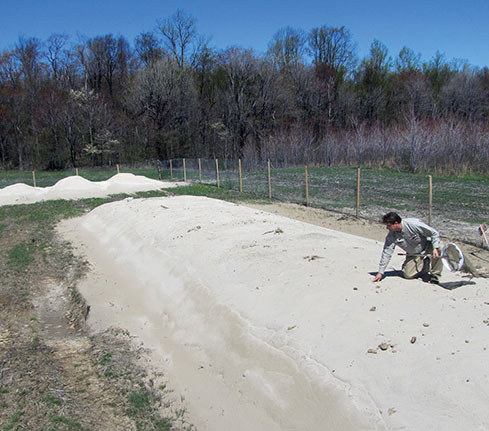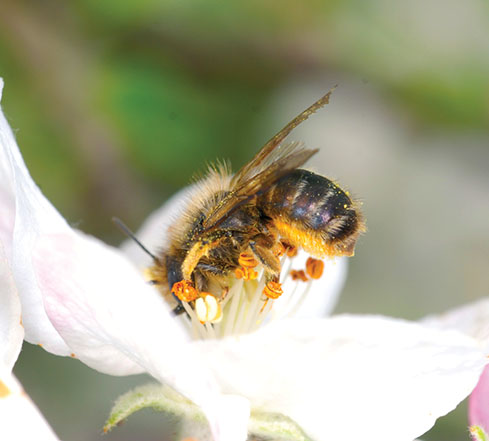 Summer 2013
Summer 2013|
“I’m just proposing that we give our native bees a nice place to live. If we build it, we’re hoping they’ll come.”
- John Wenzel, Director of Powdermill
|
Building for Bees
Honeybees get all the credit, but native bees are the real pollinating powerhouses. So scientists are looking for ways to make sure they have homes where they’re needed most. They’re not nearly as curious-looking as a baseball diamond in the middle of a cornfield, but John Wenzel’s bee-nesting dunes at Powdermill Nature Reserve still generate their fair share of head scratching. “I’m just proposing that we give our native bees a nice place to live,” says Wenzel, direc- tor of Powdermill, Carnegie Museum of Natural History’s 2,200-acre environmental research center in the Laurel Highlands. “If we build it, we’re hoping they’ll come.”
Wenzel is referring to what could be the Holy Grail of crop pollination, the native bee. While the world has been obsessing over the decline of the honeybee, entomologists like Wenzel have been trying to get the word out that native bees, not honeybees, are the pollinators of most of our fruits and vegeta- bles. So why not try managing them the way humans have been managing honeybees for thousands of years? First reported in 2006, “colony collapse disorder” among honeybees has, in fact, decimated the honeybee population, and nobody knows why. What entomologists do know is that native bees are the true work horses of so many farms and gardens around the world. “There are 20,000 species of bees; why are we only focusing on one of them?” Wenzel exclaims. Honeybees aren’t even particularly good at pollinating, he says. Why? Because they’re greedy. “They want to take all the pollen home with them. Native bees are much more efficient.” But they’re also vulnerable, since their homes are in the ground. Anything that involves tilling or bulldozing the land disrupts the natural habitat of native bees. Wenzel has been studying bees and wasps for some 30 years. A few years ago, when he was a professor in the entomology department of The Ohio State University, he started thinking seriously about the need for managing native bees. “I noticed that the local pumpkin farmers didn’t get pumpkins that year, and they were relying on honeybees,” he recounts. “Well, you can have all the honeybees in the world and you’re not going to get pumpkins.” Wenzel says that’s a lesson learned by the New York apple industry whose members became alarmed during the initial decline of the honeybee. After taking a closer look at who was pollinating what, they soon realized that it was a native bee of the genus Andrena that they had to thank for the bulk of their crop pollination. A number of entomologists, including a team at Penn State University, are particularly interested in the talents of the blue orchard bee, a primary pollinator of fruit and nut trees in the western United States. Not only could they be put into service in eastern states, but they could potentially take the place of honeybees in pollinating California’s 700,000 acres of almond trees. Theresa Pitts Singer, an entomologist with the U.S. Department of Agriculture and one of John Wenzel’s scientific collaborators, says California’s almond farmers could potentially save a bundle if they found a good alternative to the honeybee. “It costs about $200 to rent a honeybee hive for pollinating, and you need about two hives per acre for adequate pollination,” she notes. “Blue orchard bees could do a great job of pollinating almond trees.” Unfortunately, Pitts Singer notes, typical farming techniques, such as tilling the soil, disrupt the habitats of ground-burrowing native bees. And leaving areas of farmland unplanted for the sake of bee nesting doesn’t sound like a desirable option.
“Farmers totally understand that native bees are part of the system, and they never intention- ally destroy bees,” she says, adding that “no- till” farming practices offer one solution. Taking native bees on the road, like humans have been doing with honey bees for centuries, is another. “We’ve begun managing blue orchard bees,” Pitts Singer says. “We can have them sleeping in a cooler to transport them; then they’ll leave the cooler and establish themselves in the ground. But we don’t have large amounts of them yet.” Wenzel’s project, called Bulldozing for Bees: Improving Our Landscape for Native Pollinators, looks at the possibility of creating nesting sites for native bees where the pollinating services of those bees are most needed. Areas of western Pennsylvania pose a particular challenge. “We don’t have soft earth that insects can live in happily,” he explains. So after surveying the native bee population of Powdermill to create a baseline of species diversity and frequency, Wenzel and his team created two large artificial nesting areas: a 50-foot-long, flat-topped “mini-dune” composed of firmly compacted masonry sand, and a set of eight, cone-shaped “micro-dunes” made up of loose sand. “We’re really intrigued by what John’s doing,” Pitts Singer says. Wenzel hopes that, if the dunes are successful in attracting native bees, he can someday convince Marcellus Shale drillers and other companies in the business of clearing land and building roads to help create bee dunes to replace the pollinator habitats they might be disrupting. His team is also creating residential bee sandboxes that homeowners will be able to purchase and place near their gardens. “Native bees are peaceful and rarely sting,” Wenzel says, so they should be welcomed guests in any backyard habitat. As for scientific results, just don’t count on answers anytime soon, Wenzel cautions. “This is a seven- to 10-year project. It’s science—it doesn’t happen fast! And it’s the kind of project we’re especially good at here at Powdermill.”
|
Lost Kingdoms Found · Past Meets Present · Family Matters · Celebrating a Great Ride · Special Section: A Tribute to Our Donors · Chairman's Note · NewsWorthy · Face Time: Nick Bubash · Artistic License: Pop Cabaret · Field Trip: “Shocking Success” in Libya · The Big Picture
 |
Copyright © 2017 CARNEGIE Magazine. All rights reserved. |


